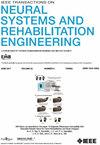Efficacy of Transcranial Magnetic Stimulation in Post-Stroke Motor Recovery: Impact of Impairment Severity
IF 4.8
2区 医学
Q2 ENGINEERING, BIOMEDICAL
IEEE Transactions on Neural Systems and Rehabilitation Engineering
Pub Date : 2025-02-20
DOI:10.1109/TNSRE.2025.3543859
引用次数: 0
Abstract
Stroke is a leading cause of impairment, with 70% of survivors experiencing upper limb motor deficits. While transcranial magnetic stimulation (TMS) is widely used in rehabilitation, the impact of impairment severity on treatment outcomes remains unclear. This study evaluated TMS effectiveness in post-stroke motor impairment and explored its neural mechanisms. Fifty-five stroke patients were divided into TMS (n =27) and control (n =28) groups. The TMS group received two weeks of intermittent theta-burst stimulation (iTBS), while controls received sham stimulation. Patients were stratified into mild/moderate (Fugl-Meyer Assessment [FMA]经颅磁刺激对脑卒中后运动恢复的疗效:损伤严重程度的影响
中风是损伤的主要原因,70%的幸存者有上肢运动障碍。虽然经颅磁刺激(TMS)广泛应用于康复治疗,但损伤严重程度对治疗结果的影响尚不清楚。本研究评估经颅磁刺激治疗脑卒中后运动障碍的有效性,并探讨其神经机制。55例脑卒中患者分为经颅磁刺激组(n =27)和对照组(n =28)。经颅磁刺激组接受为期两周的间歇性脉冲刺激(iTBS),而对照组接受假刺激。患者被分为轻度/中度(Fugl-Meyer评估[FMA] $ 30)和重度(FMA <30)损伤亚组。治疗前后分别评估运动功能和脑电图(EEG)指标。总的FMA改善在两组之间没有差异,但tms轻度/中度损伤组比其他组表现出更大的改善。该组表现出较高的全局和局部α波段功率和全局α效率。FMA改善与局部α功率变化呈正相关。同侧M1经颅磁刺激可改善轻/中度损伤患者的运动功能,但在严重病例中效果有限。脑电图提示经颅磁刺激通过调节α活动和提高神经网络效率来促进恢复。这些发现支持分层治疗方法,并强调了对严重损伤进行替代干预的必要性。
本文章由计算机程序翻译,如有差异,请以英文原文为准。
求助全文
约1分钟内获得全文
求助全文
来源期刊
CiteScore
8.60
自引率
8.20%
发文量
479
审稿时长
6-12 weeks
期刊介绍:
Rehabilitative and neural aspects of biomedical engineering, including functional electrical stimulation, acoustic dynamics, human performance measurement and analysis, nerve stimulation, electromyography, motor control and stimulation; and hardware and software applications for rehabilitation engineering and assistive devices.

 求助内容:
求助内容: 应助结果提醒方式:
应助结果提醒方式:


